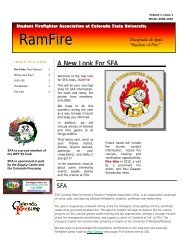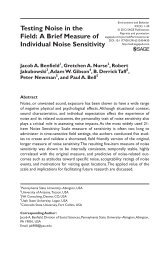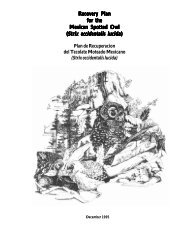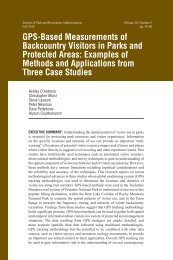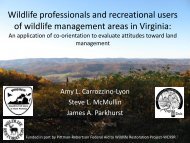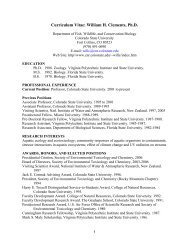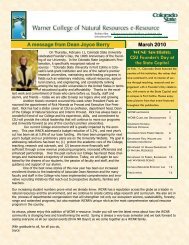sharon baruch-mordo education - Colorado State University
sharon baruch-mordo education - Colorado State University
sharon baruch-mordo education - Colorado State University
You also want an ePaper? Increase the reach of your titles
YUMPU automatically turns print PDFs into web optimized ePapers that Google loves.
EDUCATION<br />
SHARON BARUCH-MORDO<br />
Spatial Scientist<br />
The Nature Conservancy<br />
117 E Mountain Avenue, Suite 200<br />
Fort Collins, <strong>Colorado</strong> 80524<br />
E-mail: s<strong>baruch</strong>-<strong>mordo</strong> (at) tnc.org<br />
Website: http://warnercnr.colostate.edu/~<strong>sharon</strong>bm/<br />
Ph.D. Candidate, Ecology<br />
<strong>Colorado</strong> <strong>State</strong> <strong>University</strong><br />
Dissertation: Black bear ecology and human-bear interactions in an urban system<br />
M.S. Fishery and Wildlife Biology<br />
<strong>Colorado</strong> <strong>State</strong> <strong>University</strong><br />
Thesis: Black bear-human conflicts in <strong>Colorado</strong>: spatiotemporal patterns and predictors<br />
B.S. Wildlife Biology<br />
<strong>Colorado</strong> <strong>State</strong> <strong>University</strong><br />
Top 1% of graduates in the College of Natural Resources<br />
A.S. Environmental Biology<br />
Northwest College<br />
EMPLOYMENT<br />
Research positions<br />
Spatial Scientist<br />
The Nature Conservancy<br />
2012<br />
2007<br />
2001<br />
2000<br />
2012 - present<br />
• Participate in the ongoing development of conservation tools and models as part of the Sage Grouse<br />
Initiative conservation collaboration<br />
• Conduct landscape analyses and ecological modeling for Development by Design conservation<br />
projects<br />
Ph.D. Graduate Research Assistant<br />
Dept. of Fish, Wildlife, and Conservation Biology, <strong>Colorado</strong> <strong>State</strong> <strong>University</strong><br />
2007 - 2012<br />
• Led a multi-agency project between <strong>Colorado</strong> <strong>State</strong> <strong>University</strong>, National Wildlife Research Center,<br />
and the <strong>Colorado</strong> Division of Wildlife<br />
• Project design and modeling experience: conducted experiments to assess efficacy of management;<br />
managed and modeled large GPS datasets; developed patch selection models to evaluate management<br />
effects on bear foraging; developed a method of analyzing GPS activity data using sine curve<br />
• Field operations experience: hired and supervise field crews and students; led bear trapping and<br />
tracking; obtain sampling permission and in-kind support from private landowners, municipalities,<br />
federal agencies, and science-based organizations<br />
• Communication: published and presented in professional, public, and media venues
EMPLOYMENT (CONT.)<br />
Research Assistant (half-time postdoc equivalent)<br />
Dept. of Fish, Wildlife, and Conservation Biology, <strong>Colorado</strong> <strong>State</strong> <strong>University</strong><br />
2010 – 2011<br />
• Modeled species distribution in the USFWS Great Plains Landscape Conservation Collaborative as<br />
proof-of-concept for a newly developed ArcGIS tool<br />
• Modeling experience: obtained and prepared species distribution data and explanatory variables GIS<br />
data; implemented resource selection function modeling using two approaches of availability<br />
sampling and compared results; generated predictive maps of species distribution under climate<br />
change scenarios<br />
• Communication: Prepared a final report<br />
M.S. Graduate Research Assistant<br />
Dept. of Fish, Wildlife, and Conservation Biology, <strong>Colorado</strong> <strong>State</strong> <strong>University</strong><br />
2004 – 2007<br />
• Led a multi-agency project between <strong>Colorado</strong> <strong>State</strong> <strong>University</strong>, National Wildlife Research Center,<br />
and the <strong>Colorado</strong> Division of Wildlife<br />
• Spatial analysis and modeling experience: augmented, reviewed, and cleaned an 18-year database of<br />
bear human-bear conflicts; created spatiotemporal predictor attributes data from climate data; plotted<br />
conflicts in GIS and assessed conflict hot-spots; used autologistic and multi-model informationtheoretic<br />
modeling frameworks to assessed the relative important human-bear conflict predictors<br />
• Field operations experience: created protocols for genetic, aging, and trans-fatty acid sampling;<br />
created protocol for habitat sampling to assess mast production trends; assembled and distributed<br />
sample kits to 5 wildlife management areas and coordinated training, sample collection, and storage<br />
• Communication: published and presented results in professional venues<br />
Research Assistant<br />
Dept. of Fish, Wildlife, and Conservation Biology, <strong>Colorado</strong> <strong>State</strong> <strong>University</strong><br />
• Participated in a inter-agency project between <strong>Colorado</strong> <strong>State</strong> <strong>University</strong> and <strong>Colorado</strong> Department of<br />
Transportation to study Animal Vehicle Collisions (AVC) in <strong>Colorado</strong><br />
• Spatial analysis and modeling experience: summarized a 19-year AVC database for mammal and bird<br />
species; summarized temporal AVC trends by accident type; plotted AVC in GIS and assessed hotspots;<br />
obtained and summarized spatial attributes associated with AVC (e.g., highway characteristics,<br />
landcover type, Topographic Position Index)<br />
• Communication: Prepared a final report<br />
Seasonal field and work-study positions<br />
Avian surveyor<br />
EDM International, Inc., Fort Collins, CO<br />
• Conducted transect surveys for avian mortalities at communication tower sites<br />
• Monitored a web-camera at tower site<br />
2004<br />
2003-2004<br />
Research Assistant 2002<br />
<strong>Colorado</strong> Division of Wildlife, Fort Collins, CO<br />
• Entered lynx snow tracking data in Access<br />
• Processed lynx hair for DNA and stable isotope analyses<br />
Sharon Baruch-Mordo, p.2
EMPLOYMENT (CONT.)<br />
Wolf Trapping and Handling Field Technician<br />
US Geological Survey, Ely, MN<br />
• Trapped and handled wolves<br />
• Processed field samples and blood work<br />
• Remotely downloaded GPS data from collared wolves<br />
• Located deer with radio-telemetry and retrieved GPS collars<br />
• Examined wolf summer kill sites<br />
• Composed a basic user manual for ArcView 3.2<br />
Research Assistant<br />
Dept. of Wildlife Biology, <strong>Colorado</strong> <strong>State</strong> <strong>University</strong>, Fort Collins, CO<br />
• Formatted scientific papers for journal submissions<br />
• Revised and edited Pingree Park course material<br />
Research Assistant 2001<br />
Dept. of Wildlife Biology, <strong>Colorado</strong> <strong>State</strong> <strong>University</strong>, Fort Collins, CO<br />
• Conducted literature reviews and library research<br />
• Composed text and created tables and figures for a Northern Goshawk conservation assessment<br />
Lab Technician 2001<br />
Natural Resources Ecology Lab, <strong>Colorado</strong> <strong>State</strong> <strong>University</strong>, Fort Collins, CO<br />
• Created and maintained databases in Excel<br />
• Prepared herbarium mounts<br />
• Built grazing exclosures and staked them in the field<br />
Wolf Radio Telemetry Field Technician 2000<br />
US Fish & Wildlife Service, Lander, WY<br />
• Triangulated locations of collared wolves<br />
• Located and observed wolf dens<br />
ADVANCED TRAINING AND SKILLS<br />
Software and programming:<br />
R, SAS, MATLAB, WinBUGS, JAGS, ArcGIS, NetLogo, MARK, Distance<br />
Modeling concepts:<br />
Information-theoretic inference, Frequentist and Bayesian methods and inference, Individual-based<br />
models, Patch-selection models, Resource selection models, Species distribution models, Random<br />
forest models, Spatial analysis and autocorrelation, Home range estimation, Demographic parameters<br />
estimation<br />
2002<br />
2002<br />
Sharon Baruch-Mordo, p.3
ADVANCED TRAINING AND SKILLS (CONT.)<br />
Workshops:<br />
• Hierarchical models for abundance, distribution and species richness in spatially structured<br />
populations using unmarked/R and WinBUGS. USGS Patuxent Wildlife Research Center, Winter<br />
2012.<br />
• African BioMathematics Initiative (NSF-funded): Workshop and Advanced Study Institute on<br />
Conservation Biology Part I and II. Center for Discrete Mathematics and Theoretical Computer<br />
Science, Rutgers <strong>University</strong>. Kruger National Park, South Africa, Summer 2010 and Lake Naivasha,<br />
Kenya, Winter 2011<br />
• Advanced Ecological Data Analysis in R. The Wildlife Society 17 th Annual Conference, Snowbird,<br />
UT. Oct, 2010<br />
• A Brief Introduction to Bayesian and Hierarchical Bayesian Modeling in Ecology. Ecological<br />
Society of America 94 th Annual Meeting, Albuquerque, NM. Aug, 2009<br />
• Capture, Immobilization, and Handling of Wildlife. <strong>Colorado</strong> Division of Wildlife, Fort Collins,<br />
CO. 2005, 2008, and 2010<br />
• SAS Programming I: Essentials. SAS Institute, Denver, CO. Sept, 2004<br />
TEACHING<br />
Guest lecturer:<br />
• Wildlife data collection and analysis (FW471), Home range (lab), Dept. of Fish, Wildlife, and<br />
Conservation Biology, <strong>Colorado</strong> <strong>State</strong> <strong>University</strong>, Fort Collins, CO. Fall 2010 and Spring 2011.<br />
Instructors: Dr. Larissa Bailey, Dr. Paul Doherty<br />
• Wildlife data collection and analysis (FW471), Survival estimation (lecture and lab), Dept. of Fish,<br />
Wildlife, and Conservation Biology, <strong>Colorado</strong> <strong>State</strong> <strong>University</strong>, Fort Collins, CO. Spring 2007.<br />
Instructor: Dr. Ken Wilson<br />
Teaching assistant:<br />
• Wildlife data collection and analysis (FW 471; 4 credits lecture and lab), Dept. of Fishery and<br />
Wildlife Biology, <strong>Colorado</strong> <strong>State</strong> <strong>University</strong>, Fort Collins, CO. Fall 2004 and part-time Fall 2010.<br />
Instructors: Dr. Ken Wilson, Dr. Larissa Bailey<br />
• Natural resources ecology and measurements – Pingree Park (NR 220; 5 credits lecture and field<br />
lab), College of Natural Resources, <strong>Colorado</strong> <strong>State</strong> <strong>University</strong>, Fort Collins, CO. Summer 2004<br />
Workshop assistant:<br />
• MARK intermediate level, <strong>Colorado</strong> <strong>State</strong> <strong>University</strong>, Fort Collins, CO. Instructors: Dr. G. White,<br />
Dr. K. Burnham, Dr. P. Doherty, Dr. E. Cooch, et al. June, 2009<br />
• MARK beginner level, Mitrani Dept. of Desert Ecology, Sde Boker, Israel. Instructors: Dr. G.<br />
White, and Dr. D. Saltz. March, 2009.<br />
• Distance Sampling, Dept. of Fishery and Wildlife Biology, <strong>Colorado</strong> <strong>State</strong> <strong>University</strong>, Fort Collins,<br />
<strong>Colorado</strong>. Instructors: Dr. P. Doherty, Dr. J. Laake, Dr. E. Rexstad, and Dr. K. Wilson. January, 2005<br />
Sharon Baruch-Mordo, p.4
TEACHING (CONT.)<br />
Outreach:<br />
• Bears (1-day class, lecture and field), Master Naturalist Accreditation, The Forest Conservancy,<br />
Aspen, <strong>Colorado</strong>. Summer 2012<br />
PUBLICATIONS<br />
Articles and book chapter:<br />
• Baruch-Mordo, S., K.R. Wilson, S.W. Breck, D. Lewis, J.S. Mao, and J. Broderick. In Review.<br />
Facultative use of anthropogenic resources by a large carnivore: consequences of stochastic natural<br />
forage production for the management of urban black bears. Journal of Applied Ecology.<br />
• Baruch-Mordo, S., C.T. Webb, S.W. Breck, and K.R. Wilson. Accepted. Use of patch selection<br />
models as a decision support tool to evaluate mitigation strategies of human-wildlife conflict.<br />
Biological Conservation.<br />
• Baruch-Mordo, S., S.W. Breck, K.R. Wilson, and J. Broderick. 2011. The carrot or the stick?<br />
Evaluation of <strong>education</strong> and enforcement as management tools for human-wildlife conflicts. PLoS<br />
ONE e15681<br />
• Walter, D.W., J. Fischer, S. Baruch-Mordo, and K. VerCauteren. 2011. What is the proper method<br />
to delineate home range of an animal using today’s advanced GPS telemetry systems: the initial step.<br />
Modern Telemetry pp. 249 – 268. InTech, Rijeka, Croatia<br />
• Baruch-Mordo, S., S.W. Breck, K.R. Wilson, and J. Broderick. 2009. A tool box half full: how<br />
social science can help solve human-wildlife conflict. Human Dimensions of Wildlife 14:219-223<br />
• Baruch-Mordo, S., S.W. Breck, K.R. Wilson, and D.M. Theobald. 2008. Spatiotemporal distribution<br />
of black bear-human conflicts in <strong>Colorado</strong>. Journal of Wildlife Management 72:1853-1862.<br />
• Wolfe, L.L., C.T. Goshorn, and S. Baruch-Mordo. 2008. Immobilization of black bears (Ursus<br />
americanus) with a combination of butorphanol, azaperone, and medetomidine. Journal of Wildlife<br />
Diseases 44:748-752.<br />
• Thiemann, G.W., R.S. Stahl, S. Baruch-Mordo, and S.W. Breck. 2008. Trans fatty acids provide<br />
evidence of anthropogenic feeding by black bears. Human-Wildlife Conflicts 2:183-193.<br />
In preparation:<br />
• Baruch-Mordo, S., K.R. Crooks, D.M. Theobald, and K.R. Wilson. Incorporating animal-vehicle<br />
collisions clustering trends and consistency in mitigation planning. Target: Ecology and Society.<br />
• Baruch-Mordo, S., G. Wittemyer, M.B. Hooten, S.E. Reed, and D.M. Theobald. A practical guide<br />
for use of home range approaches. Target: Methods in Ecology and Evolution.<br />
• Baruch-Mordo, S., and G.K. Himes Boor. Using individual-based movement models to investigate<br />
mechanism of emergent herding behavior in African buffalo. Target: Journal of Animal Ecology.<br />
Sharon Baruch-Mordo, p.5
PUBLICATIONS (CONT.)<br />
Technical reports:<br />
• Crabtree, R., J.W. Sheldon, K. Wilson, C. Potter, B. Winkelman, D. Weiss, S. Baruch-Mordo, and<br />
G. Reese. 2011. Decision support for climate change adaptation in the GPLCC: creating geospatial<br />
data products for ecosystem assessment and predictive species modeling. Yellowstone Ecosystem<br />
Research Center report, Bozeman, MT<br />
• Crooks, K., C. Haas, S. Baruch-Mordo, K. Middledorf, S. Magle, T. Shenk, K. Wilson, and D.<br />
Theobald. 2008. Roads and connectivity in <strong>Colorado</strong>: animal-vehicle collisions, wildlife mitigation<br />
structures, and lynx-roadway interactions. Report No. CDOT-2008-4, <strong>Colorado</strong> Department of<br />
Transportation Research Branch, Denver, <strong>Colorado</strong><br />
PRESENTATIONS<br />
Professional meetings:<br />
• Baruch-Mordo, S., Evans, J., Kiesecker, J., Naugle, D., Maestas, J. 2012. Using range-wide models<br />
to inform sage-grouse conservation: data challenges and opportunities. Wyoming Chapter of The<br />
Wildlife Society annual meeting, Laramie, WY<br />
• Baruch-Mordo, S., Wittemyer, G., Hooten, M., Reed, S., Theobald, D. 2012. A practical guide for<br />
use of home range estimators. The Wildlife Society 19 th Annual Conference, Portland, OR<br />
• Baruch-Mordo, S., Webb, C.T., Breck, S.W., and Wilson, K. 2012. Patch selection models evaluate<br />
effects of conflict management on wildlife foraging. Student Conference on Conservation Science,<br />
American Museum of Natural History, New York, NY<br />
• Baruch-Mordo, S., Webb, C.T., Breck, S.W., and Wilson, K. 2012. Using patch selection models to<br />
evaluate effects of human-wildlife conflict management on wildlife foraging decisions. North<br />
American Congress for Conservation Biology, Society for Conservation Biology, Oakland, CA<br />
• Baruch-Mordo, S. 2011. Food for thought: why diversionary feeding may not be an effective<br />
management tool for urban human-bear conflicts. Invited panelist, Bear Feeding, 20 th International<br />
Conference on Bear Research and Management, Ottawa, Canada<br />
• Baruch-Mordo, S., Wilson, K.R., Breck S.W., Broderick J. 2011. Urban black bear ecology:<br />
fluctuating synanthropy and its implications for management. Poster, 20 th International Conference<br />
on Bear Research and Management, Ottawa, Canada<br />
• Baruch-Mordo, S., Breck S.W., Wilson, K.R., Broderick J. 2011. The carrot or the stick? Evaluation<br />
of <strong>education</strong> and enforcement as management tools for urban human-bear conflicts. Poster, 20 th<br />
International Conference on Bear Research and Management, Ottawa, Canada<br />
• Himes Boor, G.K., Baruch-Mordo, S. 2011. Using individual-based movement models to investigate<br />
mechanism of emergent herding behavior in African buffalo. 8 th European Conference on<br />
Mathematical and Theoretical Biology and Annual Meeting of The Society for Mathematical<br />
Biology, Krakow, Poland<br />
Sharon Baruch-Mordo, p.6
PRESENTATIONS (CONT.)<br />
• Baruch-Mordo, S., Wilson, K.R., Broderick J. 2011. Urban black bear ecology: fluctuating<br />
synanthropy and its implications for management. International Urban Wildlife Management and<br />
Planning Conference, Austin, TX<br />
• Baruch-Mordo, S., Wilson, K.R., Broderick J. 2011. Urban black bear ecology: fluctuating<br />
synanthropy and its implications for management. International Urban Wildlife Management and<br />
Planning Conference, Austin, TX<br />
• Breck S.W., Baruch-Mordo, S., Wilson, K.R., Broderick J. 2011. The carrot or the stick? Evaluation<br />
of <strong>education</strong> and enforcement as management tools for urban human-bear conflicts. International<br />
Urban Wildlife Management and Planning Conference, Austin, TX<br />
• Baruch-Mordo, S., Wilson, K.R., Breck S.W., Broderick J. 2010. Urban black bear ecology:<br />
fluctuating synanthropy and its implications for management. The Wildlife Society 17 th Annual<br />
Conference, Snowbird, UT<br />
• Baruch-Mordo, S., Wilson, K.R., Breck S.W., Broderick J. 2009. Foraging ecology of black bears in<br />
a <strong>Colorado</strong> urban setting. Carnivores 2009 by the Defenders of Wildlife, Denver, CO<br />
• Baruch-Mordo, S., Breck S.W., Wilson, K.R., Broderick J. 2009. Investigating the urban black bear<br />
legend. <strong>Colorado</strong> Chapter of The Wildlife Society summer meeting, Fort Collins, CO<br />
• Baruch-Mordo, S., Breck S.W., Wilson, K.R., Broderick J. 2009. Investigating the urban black bear<br />
legend. 10 th Western Black Bear Workshop, Reno, NV<br />
• Baruch-Mordo, S., Wilson, K.R., Breck S.W., Broderick J. 2008. Efficacy of <strong>education</strong> as a<br />
management tool in reducing bear-human conflicts in a <strong>Colorado</strong> urban setting. Pathways to<br />
Success: Integrating Human Dimensions into Fisheries and Wildlife Management, Estes Park, CO<br />
• Baruch-Mordo, S., Wilson, K.R., Breck S.W., Broderick J. 2007. Roaring fork valley urban black<br />
bear ecology. Association of Zoos and Aquariums Western Regional Conference, Wildlife<br />
Conservation in Fragmented Habitats session, Denver, CO<br />
• Baruch-Mordo, S., Breck S.W., and Wilson, K.R. 2006. Modeling predictors of black bear-human<br />
conflicts in <strong>Colorado</strong>. 9 th Western Black Bear Workshop, Raton, NM<br />
• Baruch-Mordo, S., Wilson, K.R., and Breck S.W. 2005. Spatial and temporal distribution of black<br />
bear-human conflicts in <strong>Colorado</strong>. <strong>Colorado</strong> Chapter of the Wildlife Society winter meeting,<br />
<strong>Colorado</strong> Springs, CO<br />
• Baruch-Mordo, S., Wilson, K.R., and Breck S.W. 2004. Spatial and temporal distribution of black<br />
bear-human conflicts in <strong>Colorado</strong>. Carnivores 2004 by the Defenders of Wildlife, Santa Fe, NM<br />
Other (selected):<br />
• Baruch-Mordo, S., Wilson, K.R., Lewis, D. Breck S.W., Broderick J. 2010. Urban black bear<br />
ecology in the Roaring Fork Valley. Aspen Rotary Club, Aspen, CO<br />
• Baruch-Mordo, S., Wilson, K.R., Lewis, D. Breck S.W., Broderick J. 2010. Urban black bear<br />
ecology in the Roaring Fork Valley. Roaring Fork Audubon Society, Carbondale, CO<br />
Sharon Baruch-Mordo, p.7
PRESENTATIONS (CONT.)<br />
• Baruch-Mordo, S., Wilson, K.R., Breck S.W., Broderick J. 2010. Nuisance Black Bear Conflicts in<br />
<strong>Colorado</strong> – modifying, understanding, and predicting human and bear behaviors in an urban setting.<br />
Berryman Institute Symposium, Logan, UT<br />
• Baruch-Mordo, S., Wilson, K.R., Breck S.W., Broderick J. 2009. Urban Bears. Rocky Mountain<br />
National Park, Science Behind the Scenery Series, Estes Park, CO<br />
• Baruch-Mordo, S., Wilson, K.R., Breck S.W., Broderick J. 2009. Urban black bear ecology –<br />
Understanding, modifying, and predicting bear and human behavior. Interactions of Society and the<br />
Environment seminar series, USGS Science Center, Fort Collins, CO<br />
• Baruch-Mordo, S., Wilson, K.R., Breck S.W., Broderick J. 2008. Black bear-human conflicts:<br />
Understanding, modifying, and predicting human and bear behaviors in a <strong>Colorado</strong> urban setting.<br />
Berryman Institute symposium, Starkville, MS<br />
• Baruch-Mordo, S., Wilson, K.R., Breck S.W., Broderick J. 2007. Roaring fork valley urban black<br />
bear ecology. Aspen Center of Physics, Aspen, CO<br />
• Baruch-Mordo, S., and Wright K. 2007. Urban black bear ecology. Aspen Center for Environmental<br />
Studies, Aspen, CO<br />
• Broderick, J., Baruch-Mordo, S., Breck S.W., and Wilson, K.R. 2006. Roaring Fork valley urban<br />
black bear study: a search for better solutions to manage bear-human conflicts. A joint presentation<br />
before the <strong>Colorado</strong> Wildlife Commission, Steamboat Springs, CO<br />
Media interviews:<br />
• Radio: <strong>Colorado</strong> Public Radio, Utah Public Radio<br />
• TV: Denver 7, CBS4 Denver, Aspen Plum TV<br />
• Newspaper: Denver Post, Aspen Times, Fort Collins <strong>Colorado</strong>an, Glenwood Springs Independent,<br />
Grand Junction Daily Sentinel, Wall Street Journal<br />
ACADEMIC HONORS<br />
• School of Global Environmental Sustainability Leadership Fellow – <strong>Colorado</strong> <strong>State</strong> <strong>University</strong> 2012<br />
• International Presidential Fellow – <strong>Colorado</strong> <strong>State</strong> <strong>University</strong> 2010<br />
• Dale Hein Award for Pingree Park Summer Field Course – <strong>Colorado</strong> <strong>State</strong> <strong>University</strong> 2001<br />
- Awarded to the most enthusiastic student demonstrating academic excellence<br />
• Dean’s List – College of Natural Resources, <strong>Colorado</strong> <strong>State</strong> <strong>University</strong> 2000-2001<br />
• Writing in the Academic World essay contest winner – Northwest College 2000<br />
- E.O. Wilson – A Biography<br />
• Outstanding Full-time Adult Student Award – Northwest College 2000<br />
• President’s Honor Roll – Northwest College 1998-2000<br />
Sharon Baruch-Mordo, p.8
GRANTS, FELLOWSHIPS, AND AWARDS<br />
Research grant:<br />
• Ungulate use of escape ramps: design and monitoring – 2012, <strong>Colorado</strong> Department of<br />
Transportation, co-PI Dr. Ken Wilson ($71,944)<br />
Scholarships, fellowships, and student grants:<br />
(Unspecified amounts indicate award was



